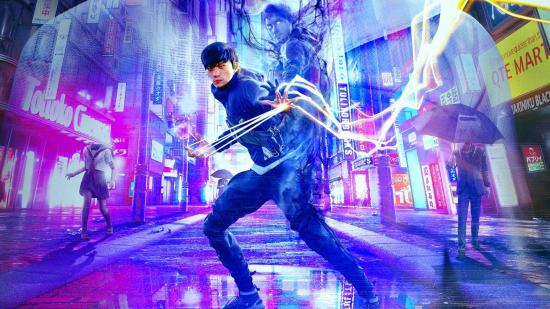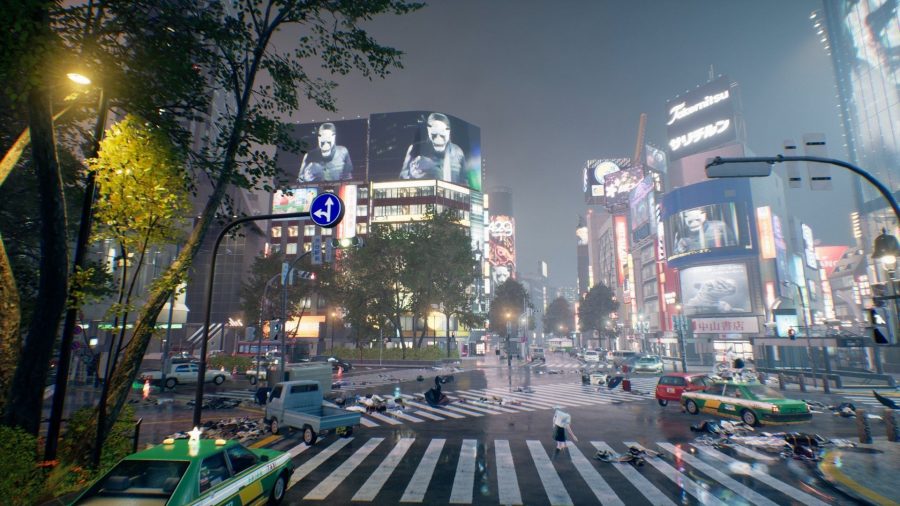Ghostwire Tokyo has been an exciting proposition since its announcement. A scary supernatural tale set in the country that does out-there horror better than most with legendary Resident Evil creator Shinji Mikami attached? I’m in. But after recently seeing a sizable chunk of the game’s beginning, as well as lots of combat, UI, and other gameplay elements, one thought keeps ringing around in my old noggin: Ghostwire Tokyo just doesn’t feel like a Shinji Mikami game.
It’s a thought that became clear as day as the player in the pre-recorded preview video explored Tokyo, giving us a good idea of how Ghostwire Tokyo will actually play. You are Akito, a young man who finds himself fused with KK, a ghost hunter turned spirit who lives in your right hand, it seems. This is presumably how you get what I like to call your finger powers, because, well, you shoot powers from your fingers.
The story involves trying to release the spirits of Tokyoites who were absorbed by a mysterious fog that descended on the city. The fog seems to be the work of a villain named Hannya, who is the person in the mask we’ve seen in previous Ghostwire Tokyo trailers. How might you free the spirit-remnants of Tokyo’s citizens you might ask? With a katashiro, of course. This object is found at an early shrine, and it allows you to absorb spirits littered around the urban sprawl and deliver them to a phone box.
These shrines are important to note, moreso for creating a disconnect between Mikami and his legendary body of work. From the footage, cleansing shrines is likely to be a large part, if not the sole focus, of Ghostwire Tokyo.
These traditional Japanese shinto shrines are surrounded by a group of enemies that you have to eliminate with your finger powers, before then walking up to the shrine’s torii gate (the large gateways you often see in images from Japan) and cleansing it by holding a button. This makes a portal-thing disappear, allowing you to enter the shrine proper and approach the altar, which is where you can find rewards.
Imagine my surprise, then, when the camera zoomed out and panned around Ubisoft-style in a ‘hey, good on you for clearing this tower’ way. You had my curiosity, Tango Gameworks, but now you have my attention. Trying to displace my doubts as the preview continued, I pondered whether this concept of clearing shrines could indeed make up a significant part of the gameplay loop. Surely not.
There were some interesting story tidbits and cutscenes that prove there will be actual missions, too, as well as side missions featuring cute cats and animals that help you out on your journey to rid Tokyo of evil spirits. But, it wasn’t long before we were back at a shrine, but this time one on top of a skyscraper, with winged enemies flying about. To get there, you used a grapple, before taking on the bad guys with your finger powers, and, then cleanse the shrine afterwards in the same style we’d seen earlier.
And get this: there was a third shrine in the preview, dear reader, and I do not jest. It was a larger one this time, set among a more expansive temple complex, but the concept was the same – destroy the enemies, cleanse the shrine, get loot. The supernatural finger power combat combined with some of the other movement mechanics like grapple gave off a very Dishonored vibe, while the shrine cleansing oozed Ubisoft busywork. Sprinkle in some Japanese folklore wrapping, and you have a game that I wasn’t expecting to come from Shinji Mikami or the Tango Gameworks team.
The legend of survival horror, Mikami was in charge of creating genre classics like Resident Evil, Resident Evil 4, and Dino Crisis. In recent years, he directed and produced The Evil Within and its sequel, games that received very favourable critical reviews. And, more importantly, both titles continued the survival horror legacy. Ammo was scarce, enemy design was uniquely perturbing, and the dark and grimy environments created an atmosphere of pure dread.
Not only is Ghostwire Tokyo played from a first-person point of view, which breaks from the tried and tested third-person camera they are known for, but the combat appears quite basic and there doesn’t appear to be much regard given to ammo consumption. Similarly, being set slap bang in the centre of Tokyo means that the environments aren’t quite on the spine-chilling level we see in games like The Evil Within. There are sequences when you are sucked into otherworldly versions of various locations, and these are certainly spookier than the rest of the gameplay, but things still seem to lack the character of true horror.
The enemy types observed so far also fail to reflect the kinds of nightmares you’d expect from something touched by Mikami’s hand. One such enemy type, for example, is a faceless slenderman, who attacks you with other slendermen in a straight-on rush in the middle of the city. Another adversary you’ll come up against are the weird bird-creatures we mentioned earlier, and together with the slender-baddies, makes obvious how their cookie-cutter designs just aren’t scary.
The more action orientation of Ghostwire Tokyo is accentuated further than just its lack of traditional survival horror elements and unscary enemies; it stretches to world design. If there’s one thing Mikami knows how to do, it’s create the claustrophobic environments that inspire so much of the heart-racing horror genre. The hospital in The Evil Within, for example, where you’re forced to creep around a chainsaw-wielding maniac, or the cramped corridors of Spencer Mansion in Resident Evil.
Setting Ghostwire Tokyo in, well, Tokyo removes a lot of the tension that these locales provided. No longer will you feel the fear of having your back against the wall with only two bullets left as a zombie bears down on you. In Ghostwire, you can just find something else to do on the minimap.
With that in mind, Ghostwire Tokyo looks more like an open-world Bethesda experience, rather than a carefully crafted Tango Gameworks one right now. It’s a game that belies Mikami’s involvement in the project, and instead has more of an air of Todd Howard or Arkane Lyon about it.


